
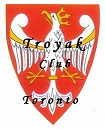
HAPPY NEW YEAR 2023
BONNE ANNÉE 2023

SZCZĘŚLIWEGO NOWEGO ROKU 2023
FELIZ AÑO NUEVO 2023

TROYAK EXECUTIVE TEAM is informing all members, colleagues, collectors, and Polonia at large, that Club meetings taking place at John Paul II Polish Cultural Centre, 4300 Cawthra Rd. (just south of Hwy. 403), Mississauga, Ontario. The new members are always welcome. www.polishculturalcentre.ca
ADRES SPOTKAÑ KLUBOWYCH ! Zarząd Główny Klubu “Troyak” informuje wszystkich członków kolekcjonerów, sympatyków oraz całą Polonię, że spotkania klubowe odbywają się w Polskim Centrum Kultury im. Jana Pawła II, przy 4300 Cawthra Rd. (na południe od autostrady 403), Mississauga, Ontario. Zapraszamy nowych członków do prężnego. Klubu “Troyak”. www.polishculturalcentre.ca
“TROYAK” CLUB NEXT MEETINGS …
NASTĘPNE SPOTKANIA KLUBU “TROYAK” …

15th January 2023 @ 4:30 p.m. …
… Annual General Meeting
29th January 2023 @ 4:30 p.m.
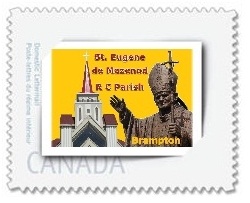
26th February 2023
Sunday – 5th March 2023 @ 9:00 a.m. to 4:00 p.m.
Mississauga Coin & Stamp Show
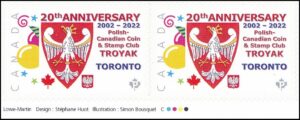
26th March 2023; 30th April 2023
28th May 2023; 25th June 2023

July & August 2023 – Summer break … Letnie wakacje …
30th September 2023; 29th October 2023
26th November 2023
December 2023 … Happy Holidays!

Św. Rafał Kalinowski
www.poczta-polska.pl
W dniu 11 listopada 2022 roku został wprowadzony do obiegu znaczek pocztowy o wartości 3,90 zł emisji “Św. Rafał Kalinowski”. Na znaczku przedstawiono wizerunek św. Rafała Kalinowskiego w formie obrazu namalowanego na podstawie jedynego zachowanego zdjęcia. Wzdłuż dolnej krawędzi umieszczono zwielokrotniony herb Zakonu Karmelitów Bosych tworzących wzór i napis: ŚW. RAFAŁ KALINOWSKI. Wzdłuż lewej krawędzi znajduje się napis: POLSKA i oznaczenie wartości 3,90 zł. Na kopercie: fragment obrazu Jerzego Kumala; „W drodze na Syberię”. W części centralnej koperty hasło, przesłanie świętego: ,,Jestem dla wszystkich”. Obrazy zarówno ze znaczka jak i koperty znajdują się w Klasztorze Karmelitów Bosych w Czernej. Na datowniku: zarys wież Klasztoru Karmelitów Bosych w Czernej. Wnioskodawcą jest Krakowska Prowincja Zakonu Karmelitów Bosych – o. prowincjał Stanisław Fudala.
Konsultacje merytoryczne Klasztor Karmelitów Bosych w Czernej ojciec przeor Paweł Hańczak. Materiały pozyskane z Archiwum prowincji we współpracy o. Jerzy Zieliński. Znaczek emitowany w związku z instalacją relikwii w świątyni Bożej Opatrzności na uroczystościach 11 listopada 2022 roku w obecności Prezydenta Andrzeja Dudy. Św. Rafał Kalinowski patron żołnierzy i sybiraków. Podczas uroczystości instalacji relikwii w świątyni Bożej Opatrzności w Warszawie Poczta Polska złożyła znaczek w darze ołtarza. Znaczki wydrukowano techniką offsetową, na papierze fluorescencyjnym, w formacie 31,25 x 39,5 mm, w nakładzie 144 000 sztuk. Arkusz sprzedażny zawiera 12 sztuk znaczków (tete-beche), gdzie co drugi znaczek jest odwrócony o 180 stopni w stosunku do znaczka sąsiadującego. Z tej okazji została wydana koperta FDC. Autor projektu: Paweł Myszka.

Bohater emisji filatelistycznej Poczty Polskiej był uczestnikiem powstania styczniowego, a wcześniej zrezygnował z pracy w rosyjskim wojsku w obawie przed otrzymaniem rozkazu walki przeciwko rodakom. Objął stanowisko ministra wojny w litewskich władzach powstańczych. Po upadku insurekcji był skazany na śmierć, wyrok ten zamieniono mu na karę zsyłki na Syberię. Tam odkrył powołanie zakonne. W 1874 roku został zwolniony z wygnania, po trzech latach wstąpił do zakonu karmelitańskiego, przyjął święcenia kapłańskie 15 stycznia 1882 roku. Trzykrotnie sprawował funkcję przeora klasztoru w Czernej, był też przełożonym klasztoru w Wadowicach. Spędził w zakonie 30 lat. Zmarł 15 listopada 1907 roku w Wadowicach. Jan Paweł II kanonizował go 17 listopada 1991 roku w Rzymie. Rafał Kalinowski jest pierwszym karmelitą kanonizowanym po św. Janie od Krzyża.

50. rocznica nawiązania polsko-tajlandzkich
stosunków dyplomatycznych
www.poczta-polska.pl
W dniu 14 listopada 2022 roku zostały wprowadzone do obiegu dwa znaczki pocztowe o wartości 4,00 zł emisji “50. rocznica nawiązania polsko-tajlandzkich stosunków dyplomatycznych”. Na pierwszym znaczku znajduje się Pałac na Wodzie w Łazienkach Królewskich w Warszawie; Na drugim znaczku znajduje się Pawilon Aisawanthipphaya-At w Królewskim Zespole Pałacowym Bang Pa-In. W prawym dolnym rogu znaczków umieszczono napis: POLSKA, a lewym dolnym oznaczenie ich wartości: 4 ZŁ, w prawym górnym rogu znaczków widnieje nazwa emisji ,,50. rocznica nawiązania polsko-tajlandzkich stosunków dyplomatycznych”. Znaczki wydrukowano techniką offsetową, na papierze fluorescencyjnym, w formacie 39,5 x 51 mm, w nakładzie 240 000 sztuk (120 000 każdego). Arkusz sprzedażny zawiera 8 sztuk znaczków. Z tej okazji została wydana koperta FDC. Autor projektu: Andrzej Gosik.

Poczta Polska i Poczta Tajlandii uroczyście wprowadziły 3 grudnia w warszawskim Zamku Królewskim znaczki wspólnej emisji „50. rocznica nawiązania polsko-tajlandzkich stosunków dyplomatycznych”. Oficjalna uroczystość rozpoczęła się odegraniem hymnów narodowych. W uroczystej prezentacji uczestniczyli Urasa Mongkolnavin – ambasador Tajlandii, Nattapong Suwanpakdee – pełnomocnik ambasadora Tajlandii w Polsce oraz Krzysztof Górski – dyrektor Biura Współpracy Międzynarodowej i Filatelistyki.
Wydane znaczki przedstawiają pałace na wodzie w Polsce i w Tajlandii, które są charakterystycznymi obiektami architektonicznymi należącymi historycznie w przypadku Polski i obecnie (Tajlandia) do rodzin królewskich obu państw. Na jednym ze znaczków umieszczono reprodukcję akwareli Andrzeja Gosika, który przedstawił warszawski Pałac na Wodzie w Łazienkach Królewskich, zaś na drugim widnieje akwarela wykonana przez Thanetha Ponchaiwonga, tajskiego artysty malarza, który zilustrował Pawilon Aisawanthipphaya-At w Królewskim Zespole Pałacowym Bang Pa-In usytuowany nad rzeką Menam w dzielnicy Bang Pa-in, w prowincji Phra Nakhon Si Ayutthaya w Tajlandii, czyli tajlandzki pałac zaprojektowany i wybudowany na wodzie.

Wydanie emisji „50. rocznica nawiązania polsko-tajlandzkich stosunków dyplomatycznych” filatelistycznej w Poczcie Tajlandzkiej zaprojektowała Mayuree Narknisorn. Z kolei na wydanej w ramach tej samej emisji kopercie FDC znalazła się reprodukcja akwareli Brama Tewa Raja Kunlai. Autorem logotypu obchodów, który umieszczono na arkuszu znaczków jest Surattanachai Chuenta.
Oficjalne stosunki dyplomatyczne między Polską i Tajlandią trwają od 50. lat, jednak nieformalne kontakty między oboma państwami – o wiele dłużej. Są źródła, które komunikują o pierwszych relacjach między państwami nawet kilkaset lat temu. Wydanie wspólnej emisji filatelistycznej upamiętnia rocznicę nawiązania stosunków dyplomatycznych z krajem, z którym łączą Polskę przyjazne relacje. Emisja jest znamienna dla Poczty Polskiej, która dąży do umocnienia swojej obecności na azjatyckim rynku filatelistycznym.

Zabytkowe organy w Polsce
www.poczta-polska.pl
W dniu 17 listopada 2022 r. został wprowadzony do obiegu znaczek pocztowy w formie bloku o wartości 8,00 zł, emisji “Zabytkowe organy w Polsce”. Na kolejnym znaczku z serii “Zabytkowe organy w Polsce” prezentujemy organy barokowe z Bazyliki Mniejszej pw. św. Elżbiety we Wrocławiu.

Znaczek wydrukowano techniką offsetową, na papierze fluorescencyjnym, w formacie: format znaczka: 51 x 79 mm, format bloku: 75 x 100 mm, w nakładzie 90 000 sztuk. Z tej okazji została wydana również koperta FDC. Autor projektu znaczka: Agnieszka Sancewicz.

100-lecie powstania Administracji Apostolskiej
na Górnym Śląsku
www.poczta-polska.pl
W dniu 18 listopada 2022 r. został wprowadzony do obiegu znaczek pocztowy o wartości 3,90 zł emisji “100-lecie powstania Administracji Apostolskiej na Górnym Śląsku”. Na znaczku przedstawiono portret Augusta Hlonda, pierwszego administratora Administracji Apostolskiej na Górnym Śląsku oraz odcisk pieczęci, którą się posługiwał.
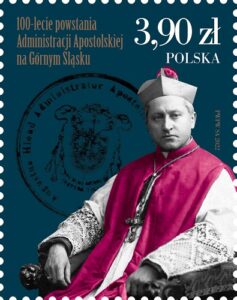
W grafice koperty FDC dekret papieski ustanawiający Administrację Apostolską na Górnym Śląsku. W grafice datownika – podpis Augusta Hlonda. Emisja powstała w ścisłej współpracy z Archiwum Archidiecezjalnym w Katowicach. Znaczek wydrukowano techniką rotograwiurową, na papierze fluorescencyjnym, format znaczka: 31,25 x 39,5 mm , w nakładzie 100.000 szt. Arkusz sprzedażny zawiera 50 szt. znaczków. Z tej okazji została wydana również koperta FDC. Autor projektu: Jan Konarzewski.

Lech Kaczyński –
Prezydent m.st. Warszawy (2002-2005)
www.poczta-polska.pl
W dniu 18 listopada 2022 r. został wprowadzony do obiegu znaczek pocztowy w formie bloku o wartości 8,00 zł, emisji “Lech Kaczyński – Prezydent m.st. Warszawy (2002-2005)”. Na znaczku przedstawiono zdjęcie Lecha Kaczyńskiego. Znaczek wydrukowano techniką offsetową, na papierze fluorescencyjnym, w formacie: format znaczka: 31,25 x 43 mm , format bloku: 70 x 90 mm , w nakładzie 90 000 sztuk. Z tej okazji została wydana również koperta FDC. Autor projektu znaczka: Andrzej Gosik.
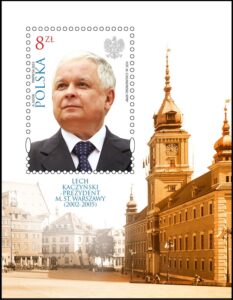
18 listopada br. w Muzeum Powstania Warszawskiego zaprezentowano nowy, okolicznościowy znaczek pocztowy emisji „Lech Kaczyński – Prezydent m.st. Warszawy (2002–2005)”. W tym dniu, 20 lat temu, późniejsza głowa państwa została zaprzysiężona na Prezydenta Stolicy. Lech Kaczyński był pierwszym włodarzem miasta wybranym bezpośrednio przez mieszkańców. Trzyletnia prezydentura Lecha Kaczyńskiego przyczyniła się do wzrostu znaczenia stolicy zarówno w kraju, jak i za granicą. Jedną z najważniejszych inicjatyw podjętych przez urzędującego od 2002 r. Prezydenta m.st. Warszawy było wybudowanie Muzeum Powstania Warszawskiego. To niezwykle ważne miejsce pamięci nie tylko popularyzuje wiedzę historyczną, ale także wzmacnia przywiązanie warszawiaków do miasta, o które tak ofiarnie walczyli nasi przodkowie. Muzeum Powstania Warszawskiego od 15 lat jest jedną z najchętniej odwiedzanych instytucji kultury w Polsce. Liczne wystawy, koncerty, filmy i wydawnictwa spopularyzowały temat Sierpniowego Zrywu – wśród kolejnych pokoleń Polaków, stanowiąc formę hołdu dla uczestników walki o wolność stolicy.
Na znaczku, wydanym w formie bloku, autor projektu – Andrzej Gosik, przedstawił wizerunek Prezydenta stolicy Lecha Kaczyńskiego, a na oprawie – Zamek Królewski w Warszawie. Poczta Polska, wraz z walorem filatelistycznym, wprowadziła również kopertę FDC (pierwszego dnia obiegu). Uwidoczniono na niej symbol i herb Warszawy, czyli pomnik Syrenki. Grafice tej towarzyszą słowa: „Odwaga i wiarygodność – Warszawa czeka na zmiany”, będące hasłem Lecha Kaczyńskiego w kampanii wyborczej w 2002 r.
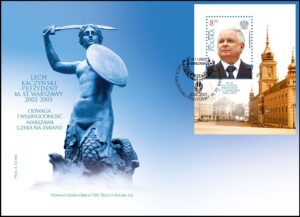
Działalność filatelistyczna Poczty Polskiej przyczynia się do promocji historii Polski, krzewienia patriotyzmu oraz budowy poczucia wspólnoty wśród Polaków. Spółka poprzez swoje znaczki przypomina o najważniejszych postaciach i wydarzeniach w historii kraju, co stanowi nie tylko walor edukacyjny, ale także kreuje wzorce, właściwe zachowania i postawy. W tym roku Poczta Polska upamiętniła m.in. Jana Olszewskiego, pierwszego premiera niekomunistycznego rządu polskiego po II wojnie światowej czy Marka Edelmana, jednego z przywódców Powstania w Warszawskim Getcie.

Światowy Dzień Pamięci Ofiar Wypadków Drogowych
www.poczta-polska.pl
W dniu 20 listopada 2022 r. została wprowadzona do obiegu kartka pocztowa z nadrukowanym znakiem opłaty pocztowej, emisji: Światowy Dzień Pamięci Ofiar Wypadków Drogowych. Wartość nominalna znaku opłaty pocztowej z oznaczeniem literowym A odpowiada wartości nominalnej znaczka pocztowego używanego do uiszczenia opłaty za ekonomiczną przesyłkę listową nierejestrowaną, w tym kartkę pocztową, w obrocie krajowym, w formacie S. W prawym górnym rogu strony adresowej kartki nadrukowano znak opłaty pocztowej, na którym umieszczono zdjęcie ratowników na miejscu wypadku drogowego. Powyżej, wzdłuż górnej krawędzi umieszczono napis: POLSKA oraz oznaczenie wartości: A.

W części ilustracyjnej kartki przedstawione zostało zdjęcie pomnika Ofiar Wypadków Drogowych i Przestępstw ,,Przejście”, natomiast wzdłuż górnej krawędzi kartki umieszczono napis: ŚWIATOWY DZIEŃ PAMIĘCI OFIAR WYPADKÓW DROGOWYCH. Kartkę o wymiarach 148 x 105 mm wydrukowano jednostronnie, techniką offsetową, na kartonie białym, w nakładzie 5000 sztuk. Autor projektu kartki: Jan Konarzewski. Autorem zdjęcia umieszczonego w części ilustracyjnej kartki pocztowej jest Pani Joanna Mężyk.

80. rocznica wybuchu Powstania Zamojskiego
www.poczta-polska.pl
Po centralnych obchodach 80. rocznicy wybuchu Powstania Zamojskiego w Warszawie, 11 grudnia 2022 r. odbyła się kolejna uroczystość upamiętniająca bohaterski zryw mieszkańców Zamojszczyzny przeciwko brutalnej polityce niemieckiego okupanta. W Zamościu przedstawiciele Poczty Polskiej złożyli Walczącym wyjątkowy hołd, prezentując z tej okazji okolicznościową kartkę pocztową.
W dniu 20 listopada 2022 r. została wprowadzona do obiegu kartka pocztowa z nadrukowanym znakiem opłaty pocztowej, emisji: 80. rocznica wybuchu Powstania Zamojskiego. Wartość nominalna znaku opłaty pocztowej z oznaczeniem literowym A odpowiada wartości nominalnej znaczka pocztowego używanego do uiszczenia opłaty za ekonomiczną przesyłkę listową nierejestrowaną, w tym kartkę pocztową, w obrocie krajowym, w formacie S. W prawym górnym rogu strony adresowej kartki nadrukowano znak opłaty pocztowej, na którym umieszczono odznakę 9 Pułku Piechoty Armii Krajowej Ziemi Zamojskiej.
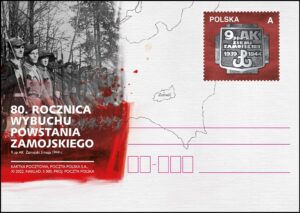
Powyżej, wzdłuż górnej krawędzi umieszczono napis: POLSKA oraz oznaczenie wartości: A. W części ilustracyjnej kartki przedstawiane zostało zdjęcie 9 Pułku Piechoty Armii Krajowej Zamojski oraz napis 80. ROCZNICA WYBUCHU POWSTANIA ZAMOJSKIEGO. Kartkę o wymiarach 148 x 105 mm wydrukowano jednostronnie, techniką offsetową, na kartonie białym, w nakładzie 5000 sztuk. Autor projektu kartki: Poczta Polska.
W grudniu 1942 roku wybuchło Powstanie na Zamojszczyźnie, które stanowiło odpowiedź polskich organizacji podziemnych na prowadzoną przez III Rzeszę Niemiecką akcji wysiedlania polskiej ludności i zasiedlania osadników niemieckich. Do walki z okupantem stanęli Żołnierze Armii Krajowej i Batalionów Chłopskich. Zacięte walki trwały w wielu miejscach, m.in. w Wojdzie, Zaborecznie, Róży oraz Osuchach. Zwycięski dla Polaków wynik Bitwy pod Zaborecznem zaskoczył Niemców, a w jej konsekwencji okupant zaprzestał kontynuowania akcji wysiedleńczej na Zamojszczyźnie.

Święci i błogosławieni – Bł. Maria Franciszka Siedliska
www.poczta-polska.pl
W dniu 25 listopada 2022 r. została wprowadzona do obiegu kartka pocztowa z nadrukowanym znakiem opłaty pocztowej, emisji: “Święci i błogosławieni”. Wartość nominalna znaku opłaty pocztowej z oznaczeniem literowym A odpowiada wartości nominalnej znaczka pocztowego używanego do uiszczenia opłaty za ekonomiczną przesyłkę listową nierejestrowaną, w tym kartkę pocztową, w obrocie krajowym, w formacie S o masie do 500 g. Założeniem projektu jest uhonorowanie 180. rocznicy urodzin Bł. Marii Franciszki Siedliskiej, założycielki Zgromadzenia Sióstr Najświętszej Rodziny z Nazaretu.
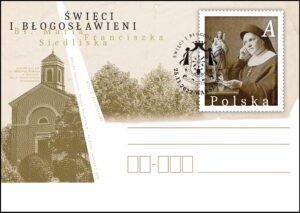
Na znaczku znajduje się wizerunek bł. Marii Franciszki Siedliskiej. W części ilustracyjnej kartki zamieszczono zdjęcie kościoła par. pw. św. Mikołaja Biskupa w Żdżarach, zaś na datowniku okolicznościowym widnieje herb zgromadzenia Nazaretanek. Kartkę o wymiarach 148 x 105 mm wydrukowano jednostronnie, techniką offsetową, na kartonie białym, w nakładzie 5000 sztuk. Autor projektu kartki: Jan Konarzewski.

Ptaki Argentyny oraz Polski
www.poczta-polska.pl
W dniu 25 listopada 2022 roku zostały wprowadzone do obiegu dwa znaczki pocztowe o wartości 4,00 zł każdy, emisji “Ptaki Argentyny oraz Polski”- wydanie wspólne Polski i Argentyny. Na znaczkach oraz w grafice koperty FDC przedstawiono zdjęcia ptaków: Garncarza Rdzawego (Furnarius Rufus) i Czubatki (L. Cristatus).

Znaczki wydrukowano techniką offsetową + raster stochastyczny, na papierze fluorescencyjnym, w formacie 51 x 39,5 mm, w nakładzie 240 000 sztuk (120 000 każdego). Arkusz sprzedażny zawiera 8 sztuk znaczków. Z tej okazji została wydana koperta FDC. Autor projektu: Paweł Myszka.
Wypełniając swoją edukacyjną rolę, Poczta Polska wprowadza do obiegu znaczki upamiętniające nie tylko postaci i wydarzenia ważne dla naszej Ojczyzny, lecz także pokazuje tematy z dziedziny techniki, kultury, nauki czy przyrody. Przykładem tej ostatniej jest najnowsza emisja „Ptaki Argentyny oraz Polski” z dwoma znaczkami i dedykowaną kopertą pierwszego dnia obiegu. Autorem polskiego znaczka jest Paweł Myszka. Do zaprojektowania grafik wykorzystał zdjęcia Macieja Zdziarskiego, autora fotografii Czubatki oraz J. Ghiorzo – Garncarza Rdzawego, którego projekt stworzyła Maria de Los Angeles Nores. Wspólna emisja z Argentyną powstała we współpracy z Ambasadą RP w Buenos Aires.
Znaczki wykonano techniką rastra stochastycznego użytą w procesie produkcji. Pozwala ona na wyeksponowanie najdrobniejszych szczegółów upierzenia przedstawionych ptaków. W barwnej grafice obu znaczków, na tle ptaków, zostały wkomponowane ich polskie i łacińskie nazwy, tytuł emisji oraz napis: Polska. Koperta FDC prezentuje oba znaczki, ich wspólną grafikę, nazwę emisji „Ptaki Argentyny oraz Polski” i datownik z datą wprowadzenia do obiegu.
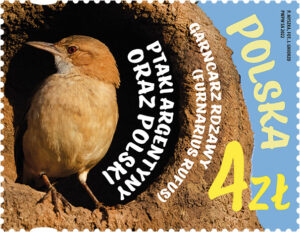
Oba gatunki ptaków budują nietypowe konstrukcje, o których warto wspomnieć. Gniazdo Garncarza Rdzawego zbudowane jest z trzciny i mułu, przypomina bardzo zamknięty garnek gliniany lub chlebowy piec. Wysiadywaniem jaj i opieką piskląt zajmuje się samiec i samica. Czubatka jako ptak lęgowy o średniej liczebności jest objęta w Polsce ścisłą ochroną gatunkową. Do budowy swoich gniazd wykorzystuje spróchniałe drzewa, w których drąży dziuple. Ciekawostką jest to, że czubatka gromadzi pożywienie na zimę, które wciska w spękania kory na drzewie, gdzie ma dziuple lub w mech ją pokrywający. Znajdują się one nisko nad ziemią (zazwyczaj do 1,5 m) i wykładane są mchem, trawami i porostami, zwieńczane zaś – włosiem i sierścią. Sporadycznie ptaki te wykorzystują też gniazda wiewiórek lub budki lęgowe, ale tylko wtedy, gdy nie będą się one znajdowały zbyt blisko ludzi, co wynika z ich płochliwości.

Poczta Polska w przeszłości wielokrotnie wydawała znaczki z podobiznami ptaków. Pierwsze dwa wydania emisji „Polskie ptaki” objęły znaczki w formie bloków, przedstawiające Zimorodka Zwyczajnego w 2014 r., a w 2019 r. przedstawiła na znaczkach: Bociana Białego, Czarnego, Czaplę Białą oraz Siwą. Natomiast w 2015 i 2017 roku do obiegu trafiły znaczki z ośmioma gatunkami rodzimych sów, m.in. Puchacza, Płomykówki, Puszczyka Mszarnego czy Uszatki. W 2019 roku wszedł do obiegu również znaczek emisji Europa prezentujący Ziębę Zwyczajną.

Marszałkowie Senatu II RP
www.poczta-polska.pl
W dniu 28 listopada 2022 roku zostało wprowadzonych do obiegu pięć znaczków pocztowych o wartości 3,90 zł każdy, emisji “Marszałkowie Senatu II RP”. Na poszczególnych znaczkach przedstawiono pięciu Marszałków Senatu II Rzeczypospolitej: Wojciecha Trąmpczyńskiego, Juliana Szymańskiego, Władysława Raczkiewicza, Aleksandra Prystora, Bogusława Miedzińskiego. Na przywieszce widnieje herb państwowy wg wzoru z 1927 roku.
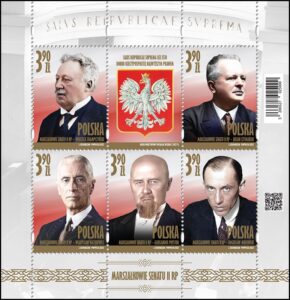
Na kopercie przedstawiono fragment widoku sali posiedzeń plenarnych Senatu II RP w trakcie debaty budżetowej 27 lutego 1934 roku. Znaczki wydrukowano techniką offsetową, na papierze fluorescencyjnym, w formacie 31,25 x 43 mm, w nakładzie 120 000 szt. każdego. Bloczek sprzedażny zawiera 5 sztuk znaczków i przywieszkę. Z tej okazji zostały wydane dwie koperty FDC. Autor projektu: Jarosław Ochendzan.

Historia polskich organizacji sportowych
www.poczta-polska.pl
W dniu 30 listopada 2022 r. została wprowadzona do obiegu kartka pocztowa z nadrukowanym znakiem opłaty pocztowej, emisji: Historia polskich organizacji sportowych. Wartość nominalna znaku opłaty pocztowej z oznaczeniem literowym A odpowiada wartości nominalnej znaczka pocztowego właściwego do uiszczenia opłaty za ekonomiczną przesyłkę listową nierejestrowaną, w tym kartkę pocztową, w obrocie krajowym, w formacie S. W części ilustracyjnej kartki przedstawiono postać zawodniczki uprawiającej biegi narciarskie na tle krajobrazu górskiego nawiązującego do logotypu LKS Klimczok Bystra. W lewej górnej części kartki umieszczono nazwę emisji ,,Historia polskich organizacji sportowych” i napis: LKS Klimczok Bystra.
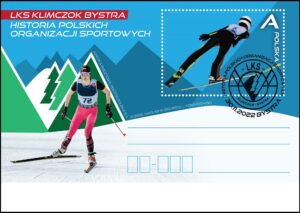
W polu znaku opłaty pocztowej w części centralnej umieszczono grafikę przedstawiającą skoczka narciarskiego. W prawym górnym rogu umieszczono oznaczenie wartości: A, a wzdłuż prawej krawędzi napis: POLSKA. Kartka została zaprojektowana we współpracy z LKS Klimczok Bystra, wnioskodawcą emisji. Wszystkie materiały graficzne użyte w emisji pochodzą od wnioskodawcy. LKS Klimczok Bystra w roku 2022 obchodzi jubileusz 100-lecia istnienia klubu. Działalność klubu obecnie skupia się na szkoleniu młodzieży w skokach i biegach narciarskich oraz kombinacji norweskiej. Kartki o wymiarach 148 x 105 mm wydrukowano jednostronnie, techniką offsetową, na kartonie białym, w nakładzie 5000 sztuk. Autor projektu kartki: Jan Konarzewski.

Wielcy polscy ekonomiści – Michał Kalecki
www.nbp.pl
Narodowy Bank Polski jest centralnym bankiem państwa odpowiadającym za politykę pieniężną i stabilność cen. Jego funkcje określa Konstytucja Rzeczypospolitej Polskiej i ustawa o NBP. NBP ma wyłączne prawo emisji pieniądza. Jako bank centralny nie prowadzi rachunków bankowych obywateli, nie przyjmuje od nich lokat, nie udziela kredytów. Prowadzi natomiast obsługę budżetu państwa, a także podmiotów sektora finansów publicznych. Gromadzi rezerwy walutowe państwa i zarządza nimi. Pełni funkcję banku banków, tworząc warunki do działania systemu bankowego. Jest również jednym z najważniejszych ośrodków naukowo-analitycznych w dziedzinie ekonomii i rynków finansowych. Emisja wartości kolekcjonerskich stanowi okazję do upamiętniania ważnych historycznych rocznic i postaci oraz do rozwijania zainteresowań polską kulturą, nauką i tradycją. 26 października 2022 roku Narodowy Bank Polski wprowadził do obiegu srebrną monetę o nominale 10 zł z serii „Wielcy polscy ekonomiści” – „Michał Kalecki”.

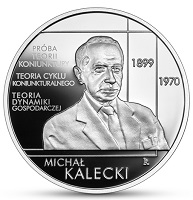
Nominał: 10 zł … metal: Ag 925/1000; stempel: lustrzany; średnica: 32,00 mm; masa: 14,14 g; brzeg (bok): gładki; nakład: do 10 000 szt.; Projektant: Robert Kotowicz; Emitent: NBP; Na zlecenie NBP monetę wyprodukowała Mennica Polska S.A.
Na rewersie monety znajdują się wizerunek Michała Kaleckiego, daty jego urodzin i śmierci oraz tytuły wybranych prac. Na awersie, poza stałymi elementami, takimi jak wizerunek orła ustalony dla godła Rzeczypospolitej Polskiej, nominał oraz oznaczenie roku emisji, umieszczony został cytat z monografii Kapitalizm. Koniunktura i zatrudnienie.
Michał Kalecki (1899–1970) był wybitnym polskim ekonomistą. Studiował na kilku uczelniach: Politechnice Warszawskiej, Uniwersytecie Warszawskim oraz Politechnice Gdańskiej, ale nie ukończył żadnej z nich – głównie z powodów finansowych. Samodzielnie zgłębiał wiedzę ekonomiczną. W 1929 r. rozpoczął pracę w Instytucie Badań Koniunktur Gospodarczych i Cen. W 1933 r. wydał wizjonerskie studium Próba teorii koniunktury, w którym przedstawił teorię efektywnego popytu. Po otrzymaniu stypendium Fundacji Rockefellera wyjechał w 1936 r. do Szwecji. Następnie osiadł w Wielkiej Brytanii, gdzie współpracował z kilkoma ośrodkami akademickimi. Nawiązał także znajomość z Johnem Maynardem Keynesem. Przełożył swoją teorię na język angielski.
Praca ukazała się w 1939 r. W czasie wojny Kalecki został zatrudniony w Oksfordzkim Instytucie Statystycznym. Od 1946 r. piastował stanowisko zastępcy dyrektora Działu Stabilizacji i Rozwoju w Departamencie Gospodarczo-Społecznym Sekretariatu ONZ. Wrócił do Polski w 1955 r. Poświęcił się wówczas przede wszystkim pracy naukowej. Wykładał w Szkole Głównej Planowania i Statystyki. Pełnił funkcję doradcy rządów kilku państw. Był kandydatem do Nagrody Nobla w dziedzinie ekonomii w 1970 r., ale śmierć uczonego zamknęła drogę do tego wyróżnienia.
Zainteresowania polskiego ekonomisty obejmowały wiele dziedzin. Kalecki zajmował się teorią koniunktury, problemami planowania gospodarczego, jak również zagadnieniami dochodu narodowego. W swoich badaniach zgłębiał teorię rozwoju gospodarczego. Szczególną wagę przykładał do kwestii zapewnienia pełnego zatrudnienia. Swoje główne koncepcje sformułował trzy lata przed Keynesem. Wszystkie publikacje Kaleckiego zostały wydane w języku angielskim. Wśród ważniejszych prac uczonego należy wymienić następujące dzieła: Próba teorii koniunktury, Essays in the Theory of Economic Fluctuations, Płace nominalne i realne, Theory of Economic Dynamics (pol. Teoria dynamiki gospodarczej), Polityczne aspekty pełnego zatrudnienia. Informacja: Grzegorz Jeż.

The Great Polish Economists – Michał Kalecki
www.nbp.pl
Narodowy Bank Polski is the central bank of the State, responsible for its monetary policy and price stability. The Bank’s functions are described in the Constitution of the Republic of Poland and the Act on NBP. NBP holds the exclusive right to issue the currency of the Republic of Poland. As the central bank, it does not provide accounts for the general public, accept deposits from or extend loans to individuals. It acts as a banker to the State budget and public sector entities. NBP also holds and manages the foreign exchange reserves of the State. Finally, it functions as a banker to banks, creating conditions for the operation of the Polish banking system. Narodowy Bank Polski is one of the most important research and analytical centres in the fields of economics and financial markets.
Issuing collector items is an occasion to commemorate important historic figures and anniversaries, as well as to develop the interest of the public in Polish culture, science and tradition. On 26 October 2022, Narodowy Bank Polski issued into circulation a silver coin of the series “The Great Polish Economists” – Michał Kalecki, with a face value of 10 złoty.


Face value: 10 zł … Metal: Ag 925/1000; Finish: proof; Diameter: 32.00 mm; Weight: 14.14 g; Edge (side): plain; Volume: up to 10,000 pcs; Designer: Robert Kotowicz; Issuer: NBP; The coins, commissioned by NBP, were struck by Mennica Polska S.A.
The reverse of the coin features the image of Michał Kalecki, the dates of his birth and death and the titles of his selected works. The obverse features – in addition to the regular elements such as the image of the Eagle established as the state emblem of the Republic of Poland, the face value and the designation of the year of issue – a quotation from his monograph Kapitalizm. Koniunktura i zatrudnienie [Capitalism. The Business Cycle and Employment].
Michał Kalecki (1899-1970) was a brilliant Polish economist. Kalecki studied at several universities: the Warsaw University of Technology, the University of Warsaw, and the Gdańsk University of Technology, but he did not graduate from any of them – mainly for financial reasons. He explored economics on his own. In 1929, he started working at the Institute of Research on Business Cycles and Prices (Instytut Badania Koniunktur Gospodarczych i Cen). In 1933, he published a visionary study Próba teorii koniunktury [An Essay on the Theory of the Business Cycle] in which he presented the theory of effective demand. After receiving the Rockefeller Foundation grant, he went to Sweden in 1936. Then, he settled in the UK, where he collaborated with several academic centres. He translated his theory into English and the work was published in 1939. Kalecki also made the acquaintance of John Maynard Keynes. During the war, Kalecki was employed at the Oxford Institute of Statistics.
From 1946, he held the post of deputy director of the Division of Economic Stability and Development in the Department of Economic Affairs of the UN Secretariat. He returned to Poland in 1955 and devoted himself primarily to academic work. He lectured at the Main School of Planning and Statistics (today SGH Warsaw School of Economics). He served as an adviser to the governments of several countries. He was a candidate for the Nobel Prize in Economics in 1970, but the scientist’s death closed the way to this award. The Polish economist’s interests covered many fields. Kalecki dealt with the theory of the business cycle, problems of economic planning, as well as issues of national income. In his research he explored the theory of economic development. He paid particular attention to the question of ensuring full employment.
He formulated his main concepts three years before Keynes. All of Kalecki’s works were published in English. Among the more important contributions of the scientist, the following works should be mentioned: Próba teorii koniunktury [An Essay on the Theory of the Business Cycle], Essays in the Theory of Economic Fluctuations, Płace nominalne i realne [Nominal and Real Wages], Teoria dynamiki gospodarczej [Theory of Economic Dynamics], Polityczne aspekty pełnego zatrudnienia [Political Aspects of Full Employment]. Info: Grzegorz Jeż.

90. rocznica powstania Znaku Rodła
www.nbp.pl
Narodowy Bank Polski jest centralnym bankiem państwa odpowiadającym za politykę pieniężną i stabilność cen. Jego funkcje określa Konstytucja Rzeczypospolitej Polskiej i ustawa o NBP. NBP ma wyłączne prawo emisji pieniądza. Jako bank centralny nie prowadzi rachunków bankowych obywateli, nie przyjmuje od nich lokat, nie udziela kredytów. Prowadzi natomiast obsługę budżetu państwa, a także podmiotów sektora finansów publicznych. Gromadzi rezerwy walutowe państwa i zarządza nimi. Pełni funkcję banku banków, tworząc warunki do działania systemu bankowego. Jest również jednym z najważniejszych ośrodków naukowo-analitycznych w dziedzinie ekonomii i rynków finansowych.
Emisja wartości kolekcjonerskich stanowi okazję do upamiętniania ważnych historycznych rocznic i postaci oraz do rozwijania zainteresowań polską kulturą, nauką i tradycją. 8 listopada 2022 roku Narodowy Bank Polski wprowadził do obiegu srebrną monetę o nominale 10 zł „90. rocznica powstania Znaku Rodła”.
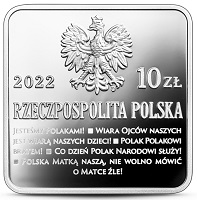

Nominał: 10 zł … metal: Ag 925/1000; stempel: lustrzany; wymiary: 28,20 × 28,20 mm; masa: 14,14 g; brzeg (bok): gładki; nakład: do 10 000 szt.; Projektant: Grzegorz Pfeifer; Emitent: NBP; Na zlecenie NBP monety wyprodukowała Mennica Polska S.A.
Na rewersie monety znajduje się Rodło – znak przedstawiający bieg rzeki Wisły wraz z zaznaczonym Krakowem. Awers przedstawia „5 Prawd Polaków” ogłoszonych w marcu 1938 r. na berlińskim Kongresie Polaków w Niemczech zorganizowanym przez ZPwN, będących podstawą ideową działalności Związku.
Odrodzone po 123 latach zaborów państwo polskie, podporządkowując się decyzji traktatu wersalskiego z 1919 r., pozostawiło w granicach państwa niemieckiego prastare zachodnie ziemie piastowskie wraz z ponadmilionową rzeszą autochtonów polskich. Wielu przeniosło się wtedy do Polski. Nie wszyscy jednak pogodzili się z decyzją mocarstw. Ci, którzy postanowili zostać, po licznych konsultacjach z polskimi środowiskami utworzyli 27 sierpnia 1922 r. w Berlinie Związek Polaków w Niemczech (ZPwN). Organizacja zobowiązała się do uzyskania dla ludności polskiej w Niemczech pełnych praw mniejszości narodowych oraz obrony jej interesów we wszystkich dziedzinach życia społecznego i kulturalnego. Wrogie państwo niemieckie w tym samym roku zakazało polskim organizacjom posługiwania się wizerunkiem Orła Białego oraz biało-czerwonym sztandarem, ponieważ były to już oficjalne symbole odrodzonej Polski. W odpowiedzi Rada Naczelna ZPwN postanowiła stworzyć własny znak tożsamości narodowej, który miał podkreślać odrębność narodową Polaków w państwie czarnego orła. Związek wielokrotnie ogłaszał konkursy na „znak polskości”, jednak bez powodzenia.
Dopiero kiedy w listopadzie 1932 r. zadanie to powierzono młodej studentce Akademii Sztuk Pięknych, znakomitej graficzce Janinie Kłopockiej, uczennicy Władysława Skoczylasa, pojawiła się szansa na realizację projektu. Artystka urodziła się w 1904 r. w wielkopolskim Koźminie. Od czwartego roku życia wychowywała się i kształciła w cesarskim Berlinie, ale dzięki rodzicom Janowi i Mariannie ukochała wszystko, co polskie i słowiańskie – to uczucie było zawsze inspiracją jej twórczości i pracy społecznej. Pewnie dlatego już podczas pierwszego spotkania 8 listopada 1932 r. w Domu ZPwN w Berlinie z taką łatwością uchwyciła sens sugestii kierownika Rady Naczelnej dr. Jana Kaczmarka, aby znak był bliski Polakom i tak prosty, by każde dziecko mogło go bez trudu narysować na piasku. Na kolejnym spotkaniu Kłopocka przedstawiła projekt graficzny symbolu ZPwN – stylizowany bieg Wisły z zaznaczonym w jej górnym odcinku Krakowem, kolebką kultury polskiej; biały znak umieściła na prostokątnym czerwonym tle. Dzięki prostocie rysunku i artystycznemu wyczuciu projekt został natychmiast zaakceptowany. Nazwę zaproponował 19-letni poeta Edmund Osmańczyk. Z połączenia dwóch słów: „rodzina” i „godło” powstało „Rodło”, które ogłoszone na zebraniu ZPwN 3 grudnia 1932 r. do dziś symbolizuje łączność Polaków przebywających poza ojczyzną z narodem polskim i jego kulturą. Informacja: Krzysztof Kłopocki.

90th Anniversary of the Rodło Sign
www.nbp.pl
Narodowy Bank Polski is the central bank of the State, responsible for its monetary policy and price stability. The Bank’s functions are described in the Constitution of the Republic of Poland and the Act on NBP. NBP holds the exclusive right to issue the currency of the Republic of Poland. As the central bank, it does not provide accounts for the general public, accept deposits from or extend loans to individuals. It acts as a banker to the State budget and public sector entities. NBP also holds and manages the foreign exchange reserves of the State. Finally, it functions as a banker to banks, creating conditions for the operation of the Polish banking system. Narodowy Bank Polski is one of the most important research and analytical centres in the fields of economics and financial markets.
Issuing collector items is an occasion to commemorate important historic figures and anniversaries, as well as to develop the interest of the public in Polish culture, science and tradition. On 8 November 2022, Narodowy Bank Polski issued into circulation a silver coin “90th Anniversary of the Rodło Sign”, with a face value of 10 złoty.


Face value: 10 zł … Metal: Ag 925/1000; Finish: proof; Dimensions: 28.20 × 28.20 mm; Weight: 14.14 g; Edge (side): plain; Mintage: up to 10,000 pcs; Designer: Grzegorz Pfeifer; Issuer: NBP; The coins, commissioned by NBP, were struck by Mennica Polska S.A.
Under the Treaty of Versailles of 1919, the Polish state, reborn after 123 years of partitions, had to relinquish the ancient western Piast lands together with over a million Polish indigenous people to the German state. Many then moved to Poland. However, not everyone accepted the decision of the world powers. Those who decided to stay, after numerous consultations with Polish communities, established the Union of Poles in Germany (Związek Polaków w Niemczech, ZPwN) in Berlin on 27 August 1922. The organisation undertook to obtain full minority rights for the Polish population in Germany and to defend its interests in all areas of social and cultural life. In the same year, the hostile German state banned Polish organisations from using the image of the White Eagle and the white-and-red banner, as they were already official symbols of the reborn Poland. In response, the ZPwN General Council decided to create its own sign of national identity, which was to emphasise the national distinctiveness of the Poles in the state of the black eagle.
The Union repeatedly announced competitions for a “sign of Polishness”, but without success. It was only when, in November 1932, the task was entrusted to a young student of the Academy of Fine Arts, the excellent graphic artist Janina Kłopocka, a pupil of Władysław Skoczylas, that a chance arose to implement the project. The artist was born in 1904 in Koźmin, Greater Poland. From the age of four, she was brought up and educated in Imperial Berlin, but thanks to her parents Jan and Marianna, she learnt to love everything Polish and Slavic – this feeling was always an inspiration for her art and social work. This is probably why already at the first meeting on 8 November 1932 at the ZPwN House in Berlin, she so easily grasped the meaning of the suggestion by Dr Jan Kaczmarek, the head of the General Council. He suggested that the sign should be familiar to the Poles and simple enough for every child to be able to easily draw it in the sand. At the next meeting, Kłopocka presented a graphic design of the ZPwN symbol – a stylised course of the Vistula with Kraków, the cradle of Polish culture, marked in its upper reaches; she placed the white sign against a rectangular red background.
Thanks to the simplicity of the drawing and artistic finesse, the design was immediately accepted. The name was proposed by the 19-year-old poet Edmund Osmańczyk. The combination of the Polish words for “family” (rodzina) and “emblem” (godło) created “Rodło”. It was announced at the ZPwN meeting on 3 December 1932, and has symbolised the connection of the Poles living outside their homeland with the Polish nation and its culture ever since. The reverse of the coin features Rodło, a sign depicting the course of the Vistula River with Kraków marked on it. The obverse depicts the ”Five Truths of Poles” proclaimed in March 1938 at the Berlin Congress of Poles in Germany organised by the ZPwN, which are the ideological basis of the Union’s activities. Info: Krzysztof Kłopocki.


Canadians in Flight:
PermanentTM domestic rate stamps
www.canadapost.ca
This booklet of 10 PermanentTM domestic rate stamps celebrate Canada’s rich aviation history. It depicts all 5 stamp designs (2 each of 5 designs) from our Canadians in Flight (Part 2) issue. Brave Canadians took to the skies when airplane flight was still in its early stages. As a result, Canada has enjoyed many “firsts” in the world of aviation and aeronautics and Canadians have made significant contributions to global advances in the fields of aviation and aeronautics, with some contributions remaining the foundation for ongoing advancement in these fields.
This second edition of the Canadians in Flight series honours the people, planes and technology that have allowed Canada’s reputation for innovation to soar. It builds on the design of the 5 stamps in the first issue of Canadians in Flight (2019). These stamps celebrate an iconic aircraft, Canadian flight simulator innovation and individuals who took Canadian aviation and technology to new heights.
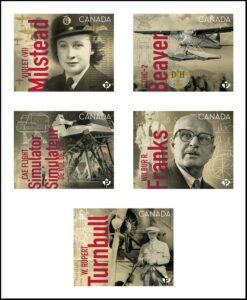
*** Violet (Vi) Milstead was one of Canada’s first female bush pilots, and also ferried military aircraft in Britain during the Second World War.
*** The de Havilland Canada DHC-2 Beaver is considered the best bush plane ever built.
*** Thanks to Canada’s CAE Inc. and its founder, aviator Kenneth Patrick, most airline pilots around the world receive their training in Canadian-made flight simulators. 2022 marks the 75th anniversary of the company.
*** Wilbur Rounding Franks invented the G-suit, which prevented pilots from losing consciousness during high gravitational force manoeuvres.
*** Pioneering aeronautical engineer W. Rupert Turnbull developed the variable pitch propeller, which greatly improved aircraft performance.
Stamp Designer: Ivan Novotny, Taylor | Sprules Corporation; Stamp Value: Permanent™ domestic rate; Quantity Produced: 170,000; Issue Date: October 17, 2022.
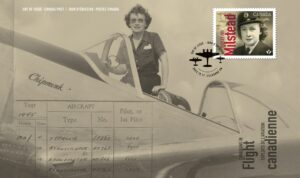
Canadians in Flight – Violet Milstead: Official First Day Cover … This Official First Day Cover celebrates Canada’s rich aviation history. It depicts Violet Milstead who is featured in 1 of 5 stamp designs from our Canadians in Flight (Part 2) issue.
Brave Canadians took to the skies when airplane flight was still in its early stages. As a result, Canada has enjoyed many “firsts” in the world of aviation and aeronautics and Canadians have made significant contributions to global advances in the fields of aviation and aeronautics, with some contributions remaining the foundation for ongoing advancement in these fields.
This second edition of the Canadians in Flight series honours the people, planes and technology that have allowed Canada’s reputation for innovation to soar. It builds on the design of the 5 stamps in the first issue of Canadians in Flight (2019). These stamps celebrate an iconic aircraft, Canadian flight simulator innovation and individuals who took Canadian aviation and technology to new heights.
One of Canada’s first female bush pilots, Toronto-born Violet (Vi) Milstead (1919-2014) earned her private pilot’s licence in 1939. She then obtained her commercial licence and instructor’s rating and taught at Toronto’s Barker Field until aviation fuel became rationed during the World War II. Milstead joined Britain’s Air Transport Auxiliary, ferrying military aircraft between the factories and front-line squadrons. Over her 28 months with the civilian organization, she logged more than 600 hours and flew 47 types of aircraft from single-engine fighters to large multi-engine bombers. Among her many honours, Milstead received the Amelia Earhart Medal and the Queen Elizabeth II Diamond Jubilee Medal. She was inducted into Canada’s Aviation Hall of Fame and a Member of the Order of Canada. This OFDC is cancelled in Colborne, Ontario as Milstead was a long-time resident. Stamp Designer: Ivan Novotny, Taylor | Sprules Corporation; Stamp Value: Permanent™ domestic rate; Cancellation Site: Colborne ON; Quantity Produced: 1,500; Issue Date: October 17, 2022.

Canadians in Flight – DHC-2 Beaver: Official First Day Cover … This Official First Day Cover celebrates Canada’s rich aviation history. It depicts The de Havilland Canada DHC-2 Beaver, which is featured in 1 of 5 stamp designs from our Canadians in Flight (Part 2) issue.
Brave Canadians took to the skies when airplane flight was still in its early stages. As a result, Canada has enjoyed many “firsts” in the world of aviation and aeronautics and Canadians have made significant contributions to global advances in the fields of aviation and aeronautics, with some contributions remaining the foundation for ongoing advancement in these fields.
This second edition of the Canadians in Flight series honours the people, planes and technology that have allowed Canada’s reputation for innovation to soar. It builds on the design of the 5 stamps in the first issue of Canadians in Flight (2019). These stamps celebrate an iconic aircraft, Canadian flight simulator innovation and individuals who took Canadian aviation and technology to new heights.
The DHC-2 Beaver is considered the best bush plane ever built. The Engineering Centennial Board named the Beaver one of Canada’s top ten engineering achievements of the 20th century. Due to its short take-off and landing capability, flexibility to be fitted with wheels, floats or skis and its ability to carry up to nine passengers or bulk cargo, it has been employed in forestry patrol, water-bombing, aerial photography, aerial fish stocking, crop dusting and cargo delivery. It made its first flight on August 16, 1947. When production ended in 1968, de Havilland Canada had produced a total of 1,692 Beavers (including 60 powered by turbines), delivered to 62 countries. It is still in use today. This OFDC is cancelled in Downsview, Ontario, which was the location of its first flight. Cancellation Site: Downsview ON; Stamp Designer: Ivan Novotny, Taylor | Sprules Corporation; Stamp Value: Permanent™ domestic rate; Quantity Produced: 1,500; Issue Date: October 17, 2022.
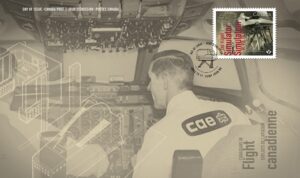
Canadians in Flight – CAE Flight Simulator: Official First Day Cover … This Official First Day Cover celebrates Canada’s rich aviation history. It depicts CAE Flight Simulator technologies, which is featured in 1 of 5 stamp designs from our Canadians in Flight (Part 2) issue.
Brave Canadians took to the skies when airplane flight was still in its early stages. As a result, Canada has enjoyed many “firsts” in the world of aviation and aeronautics and Canadians have made significant contributions to global advances in the fields of aviation and aeronautics, with some contributions remaining the foundation for ongoing advancement in these fields.
This second edition of the Canadians in Flight series honours the people, planes and technology that have allowed Canada’s reputation for innovation to soar. It builds on the design of the 5 stamps in the first issue of Canadians in Flight (2019). These stamps celebrate an iconic aircraft, Canadian flight simulator innovation and individuals who took Canadian aviation and technology to new heights.
Flight simulators have existed since the late 1920s. It was, however, former Royal Canadian Air Force (RCAF) officer Kenneth Patrick (1915-2002), of Saint John, New Brunswick, who brought the technology to Canada through Canadian Aviation Electronics Ltd. (now CAE Inc.) the company he founded in 1947. Their first flight simulator was built for the RCAF in the early 1950s and, several years later, CAE built the first for a Canadian commercial airline (Canadian Pacific). In 1976 CAE was chosen to design a simulator to replicate the functionality of the Canadarm for NASA’s space shuttle. By the early 1980s, the company had developed a flight simulator so realistic it was no longer necessary for all flight training to be completed on actual aircraft. This OFDC is cancelled in Saint John, New Brunswick, which was Patrick’s birthplace. Cancellation Site: Saint John NB; Stamp Designer: Ivan Novotny, Taylor | Sprules Corporation; Stamp Value: Permanent™ domestic rate; Quantity Produced: 1,500; Issue Date: October 17, 2022.
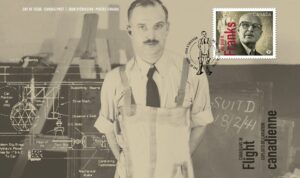
Canadians in Flight – Wilbur R. Franks: Official First Day Cover … This Official First Day Cover celebrates Canada’s rich aviation history. It depicts Wilbur R. Franks who is featured in 1 of 5 stamp designs from our Canadians in Flight (Part 2) issue.
Brave Canadians took to the skies when airplane flight was still in its early stages. As a result, Canada has enjoyed many “firsts” in the world of aviation and aeronautics and Canadians have made significant contributions to global advances in the fields of aviation and aeronautics, with some contributions remaining the foundation for ongoing advancement in these fields.
This second edition of the Canadians in Flight series honours the people, planes and technology that have allowed Canada’s reputation for innovation to soar. It builds on the design of the 5 stamps in the first issue of Canadians in Flight (2019). These stamps celebrate an iconic aircraft, Canadian flight simulator innovation and individuals who took Canadian aviation and technology to new heights.
Dr. Wilbur Rounding Franks (1901-86) was born in Weston, Ontario. In 1939 he joined Dr. Frederick Banting’s aviation medicine research team to investigate the risks of strong gravitational (G) forces, which prevent the heart from pumping enough blood to the brain and were causing pilots to lose consciousness during high-speed manoeuvres. Franks developed a flying suit lined with water-filled pockets that created enough hydrostatic pressure to counter the G-forces. He personally tested the suit – known as the Franks Flying Suit – and it became the world’s first anti-gravity suit used in combat, during the World War II. The foundational underpinnings of his G-suit are still in use today. Franks was appointed an Officer of the Order of the British Empire, awarded the United States Armed Forces’ Legion of Merit, and inducted into Canada’s Aviation Hall of Fame. This OFDC is cancelled in Weston, Ontario, which was Franks’ birthplace. Cancellation Site: Weston ON; Stamp Designer: Ivan Novotny, Taylor | Sprules Corporation; Stamp Value: Permanent™ domestic rate; Quantity Produced: 1,500; Issue Date: October 17, 2022.
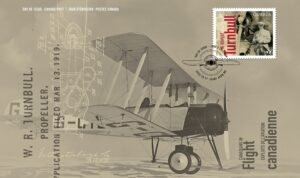
Canadians in Flight – W. Rupert Turnbull: Official First Day Cover … This Official First Day Cover celebrates Canada’s rich aviation history. It depicts W. Rupert Turnbull who is featured in 1 of 5 stamp designs from our Canadians in Flight (Part 2) issue.
Brave Canadians took to the skies when airplane flight was still in its early stages. As a result, Canada has enjoyed many “firsts” in the world of aviation and aeronautics and Canadians have made significant contributions to global advances in the fields of aviation and aeronautics, with some contributions remaining the foundation for ongoing advancement in these fields.
This second edition of the Canadians in Flight series honours the people, planes and technology that have allowed Canada’s reputation for innovation to soar. It builds on the design of the 5 stamps in the first issue of Canadians in Flight (2019). These stamps celebrate an iconic aircraft, Canadian flight simulator innovation and individuals who took Canadian aviation and technology to new heights.
Wallace Rupert Turnbull (1870-1954) was born in Saint John, New Brunswick. In 1902, the aeronautical engineer built the country’s first wind tunnel. He received the bronze medal from the Aeronautical Society of Great Britain for his leading work on aerodynamics. Turnbull’s most notable achievement was the variable pitch propeller, which allowed pilots to adjust the angle of the propeller blades in flight. This improved the efficiency of the propeller and the aircraft overall. Turnbull’s variable pitch propeller was patented in 1922, and his influence can still be seen on modern propeller-driven aircraft. Among many honours recognizing his advancements in aviation, Turnbull was named a Fellow of the Royal Aeronautical Society and inducted posthumously into Canada’s Aviation Hall of Fame. This OFDC is cancelled in Saint John, New Brunswick, which was Turnbull’s birthplace. Cancellation Site: Saint John NB; Stamp Designer: Ivan Novotny, Taylor | Sprules Corporation; Stamp Value: Permanent™ domestic rate; Quantity Produced: 1,500; Issue Date: October 17, 2022.


Tommy Prince:
PermanentTM domestic rate stamps
www.canadapost.ca
Honour the legacy of Sgt. Thomas (Tommy) George Prince, MM, with this booklet of 10, PermanentTM domestic rate stamps. Prince is one of Canada’s most-decorated Indigenous war veterans and non-commissioned officers and a prominent Anishinaabe activist.
The stamp features a photo of Sgt. Prince in his Korean War uniform. The background of northern lights symbolizes the sky above the Brokenbhead Ojibway Nation, where he was raised, about 70 kilometres northeast of Winnipeg. Sergeant Thomas (Tommy) George Prince was born in 1915 on St. Peter’s Reserve, Manitoba, into the Brokenhead Ojibway Nation., MM. He died in 1977. In 1940, during the Second World War, he enlisted with the Royal Canadian Engineers, training as a sapper. Two years later, he joined the 1st Special Service Force, a joint Canada-U.S. specialized reconnaissance and raiding unit. During his time in that unit, he was known for his marksmanship, stealth and tracking skills and sheer nerve.
Prince was remarkable. He once repaired the broken telephone line he was using to report on enemy positions by posing – in full view of German soldiers – as a farmer weeding his crops. Pretending to tie his shoelaces, he rejoined the wires and strolled back to the abandoned farmhouse to resume his reports, which resulted in the destruction of four German posts.
Prince’s bravery and service earned him the Military Medal, Silver Star (U.S.) and nine other decorations, including three (one posthumous) from the Korean War, where he did two tours of duty. Between the wars, Prince waged a different battle when, as vice-president of the Manitoba Indian Association, he spoke out in favour of abolishing the Indian Act and respecting existing treaties. Stamp Designer: Blair Thomson | Believe in; Stamp Value Permanent™ domestic rate; Quantity Produced: 200,000; Issue Date: October 28, 2022.
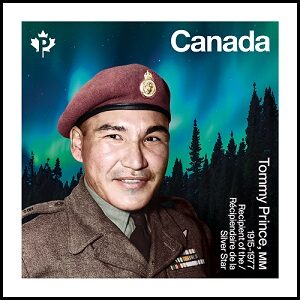
Tommy Prince: PermanentTM domestic rate stamps – pane of 5 … Honour the legacy of Sgt. Thomas (Tommy) George Prince, MM, with this pane of 5 PermanentTM domestic rate stamps. Stamp Designer: Blair Thomson | Believe in; Stamp Value: Permanent™ domestic rate; Quantity Produced: 30,000; Issue Date: October 28, 2022
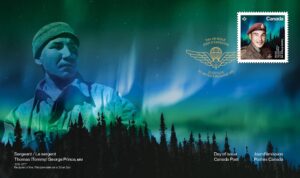
Tommy Prince: Official First Day Cover … Honour the legacy of Sgt. Thomas (Tommy) George Prince, MM, with this Official First Day Cover. Prince is one of Canada’s most-decorated Indigenous war veterans and non-commissioned officers and a prominent Anishinaabe activist. The OFDC features a photo of Sgt. Prince overlayed on a background of northern lights in the sky above the Brokenhead Ojibway Nation, where he was raised, about 70 kilometres northeast of Winnipeg. The cancel location is St. Peter’s Reserve, Manitoba (Prince’s birthplace) and a “legacy” cancel, created to mark a true birthplace in a location where no open Canada Post retail outlet currently exists. Cancellation Site: Selkirk MB; Stamp Designer: Blair Thomson | Believe in; Stamp Value: Permanent™ domestic rate; Quantity Produced: 7,000; Issue Date: October 28, 2022.

Truth and Reconciliation Keepsake
www.mint.ca
This keepsake represents a past that must never be forgotten, and a better future we can all build together. The Truth and Reconciliation Commission of Canada says that reconciliation “is a process of healing relationships that requires public truth sharing, apology, and commemoration that acknowledge and redress past harms.” It is in this spirit that we have worked with Residential, Day and Boarding school Survivors and First Nations, Inuit and Métis artists to create this Truth and Reconciliation Keepsake.
For a period of more than 150 years, First Nations, Inuit, and Métis Nation children were taken from their families and communities to attend government-funded church-run residential schools. More than 150,000 children were taken away with a goal of destroying their culture and ways of life. Thousands never came home. Neglect and abuse were widespread at these schools. Indigenous peoples are still living with the impacts of this harm. This Truth and Reconciliation Keepsake honours the Survivors and the children who never returned.
Inspired design… The design of this keepsake was a cooperative effort led by three talented Indigenous artists representing First Nations, Métis, and Inuit communities who worked together with Survivors to create an appropriate and thoughtful design marking the National Day for Truth and Reconciliation. A wearable keepsake … This dual-sided keepsake comes with a magnet attachment: choose the side you wish to display, position the keepsake on your clothing, then place the magnet on the other side of the fabric to hold it in place.
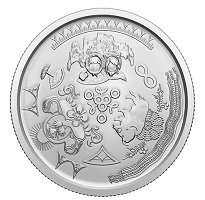

Composition: Nickel plated steel; Finish: Uncirculated;
Weight: 6.99g; Diameter: 28 mm; Edge: serrated;
Artist: JD Hawk, Jason Sikoak, Leticia Spence (reverse);
Packaging: Clear vinyl pouch enclosed in a gift card folder
About the Truth and Reconciliation Keepsake design … On one side of the keepsake, the assertion “EVERY CHILD MATTERS” appears in English and French. To the left and right we see pairs of footprints, representing ancestors walking with younger generations. At the centre of it all, orange-coloured hand prints form the shape of the sun—the life-giving source of light and heat. Within the hands is the flame motif from the National Centre for Truth and Reconciliation logo, an acknowledgement of the spiritual flame that is born inside a person, while the hands are encircled by a border representing the radiating waves of the sun’s light and heat.
The other side of the keepsake is a collection of visual elements that form an expression of Indigenous cultures and perspectives, as designed by artists Leticia Spence (First Nations), Jason Sikoak (Inuit) and JD Hawk (Métis). Forming an open circle to represent the land and the experiences shared in the vastness of the natural world, the three groupings of visual elements surround a stylized representation of roots and berries that symbolize a spiritual connection to the land, and the sustenance it provides.
First Nations rights, culture and teachings are represented by the natural element of the sun and traditional teepee lodgings; a tikanagan (cradle board) held and supported by two people, as a symbol of connection and traditional family support across generations, this is also supported by symbols of water, and a stylized fireweed flower; and to the left, a triangular motif inspired by parfleche (a rawhide carrying bag) designs.
The Inuit perspective is represented by traditional tattoo line work that was taken away by colonialists and is now coming back as a sign of pride; the northern lights that symbolize Inuit Nunangat and reflect the beauty of the North; a brother and sister—a representation of those who were sent to residential schools—bravely facing the challenge that lies before them; and to the left, an ulu which is a traditional curved knife that is used in the North.
The Métis Nation is represented by the Métis sash that signifies connection—to nature, to the past, to each other; a beadwork flower representing resilience amid thorns that signify pain and suffering; the bison, a symbol of strength and determination, bravely facing east to confront the approaching colonizers; and to the left, the infinity symbol that represents the joining of two cultures, First Nations and European, and their permanent existence as a people.
Acknowledgement … The Royal Canadian Mint is thankful for the support and contributions the National Centre for Truth and Reconciliation, the Survivor’s Circle, and the Orange Shirt Society have made to this project. JD Hawk, Métis Artist; Jason Sikoak, Nunatsiavut Artist; Leticia Spence, Cree Artist.

2022 … $2 Special Wrap Roll (coloured) –
50th Anniversary of the Summit Series
www.mint.ca www.canadapost.ca
Fifty years later, the intensity and excitement of the 1972 Summit Series between Canada and the Soviet Union (U.S.S.R.) still live on in the collective memory of Canadians, along with the heart, grit and determination demonstrated by members of Team Canada. Their legacy and team spirit are proudly honoured on the colour-enhanced 2022 commemorative $2 circulation coins that form each 50th Anniversary of the Summit Series Colourized Special Wrap Roll.
All 25 coins in each Colourized Special Wrap Roll feature the same colour on the reverse: red accents on the Team Canada 1972 Summit Series uniform (jersey, gloves and socks); and red on the team jersey’s iconic maple leaf, which rises up in the background.
The reverse design by Canadian artist Joel Kimmel features two hockey players representing Team Canada in the 1972 Canada-U.S.S.R. Summit Series. Set against the team jersey’s iconic maple leaf, which is highlighted in red on the colourized coin, the hockey players are accompanied by the words “THE SERIES LA SÉRIE” and “50 YEARS ANS”. On the outer ring, the coaches’ initials and the players’ jersey numbers surround the inner core to represent the spirit of Team Canada. The obverse features the effigy of Her Majesty Queen Elizabeth II by Susanna Blunt.
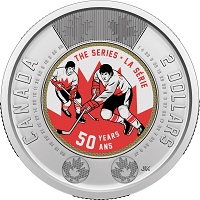
Face value: 2 dollars … Composition: Outer ring: Multi-ply nickel-plated steel, Inner core: Multi-ply brass-plated aluminum bronze; Mintage: 15,000; Finish: Circulation; Weight: 6.99g; Diameter: 28 mm; Edge: plain; Artist: Joel Kimmel (reverse).

2022 … $2 Special Wrap Roll (uncoloured) –
50th Anniversary of the Summit Series
www.mint.ca www.canadapost.ca
Fifty years later, the intensity and excitement of the 1972 Summit Series between Canada and the Soviet Union (U.S.S.R.) still live on in the collective memory of Canadians, along with the heart, grit and determination demonstrated by members of Team Canada. Their legacy and team spirit are proudly honoured on the 25 commemorative $2 circulation coins that form each 50th Anniversary of the Summit Series Special Wrap Roll.
Celebrate the 50th anniversary of the historic hockey series that captivated Canadians! Inside each Special Wrap Roll, the 25 coins share the same engraved (non-colour) design featuring the stylized Team Canada maple leaf, which was the rallying symbol for a nation in September 1972.
The reverse design by Canadian artist Joel Kimmel features two hockey players representing Team Canada in the 1972 Canada-U.S.S.R. Summit Series. On the outer ring, the coaches’ initials and the players’ jersey numbers surround the inner core to represent the spirit of Team Canada. The obverse features the effigy of Her Majesty Queen Elizabeth II by Susanna Blunt.

Face value: 2 dollars … Composition: Outer ring: Multi-ply nickel-plated steel, Inner core: Multi-ply brass-plated aluminium bronze; Mintage: 15,000; Finish: Circulation; Weight: 6.99g; Diameter: 28 mm; Edge: plain; Artist: Joel Kimmel (reverse).

2022 … $30 Pure Silver Coin –
50th Anniversary of the Summit Series
www.mint.ca www.canadapost.ca
It was a series that culminated in one of the most iconic moments in Canadian history—a “where were you when…?” moment that is cherished to this day—and those eight games ultimately changed the way hockey was played. Fifty years later, the intensity and excitement of the 1972 Summit Series between Canada and the Soviet Union (U.S.S.R.) still live on in the collective memory of Canadians, along with the heart, grit and determination demonstrated by members of Team Canada. Their legacy and team spirit are proudly honoured on this 50th Anniversary commemorative coin, which features the stylized maple leaf that was the rallying symbol for an entire nation in September 1972.
The reverse design by Canadian artist Joel Kimmel features two hockey players representing Team Canada in the 1972 Canada-U.S.S.R. Summit Series. Set against the team jersey’s iconic maple leaf, the hockey players are accompanied by the words “THE SERIES LA SÉRIE” and “50 YEARS ANS”. The coaches’ initials and the players’ jersey numbers surround the inner portion to represent the spirit of Team Canada, while the outside portion features a hockey net pattern. That hockey net pattern also appears as a background pattern on the obverse, which features the effigy of Her Majesty Queen Elizabeth II by Susanna Blunt.

Face value: 30 dollars … Composition: 99.99% Pure Silver;
Mintage: 5,000; Finish: Proof; Weight: 62.69g;
Diameter: 50 mm; Edge: plain; Artist: Joel Kimmel (reverse).

2022 … $200 Pure Gold Coin –
50th Anniversary of the Summit Series
www.mint.ca www.canadapost.ca
It was a series that culminated in one of the most iconic moments in Canadian history—a “where were you when…?” moment that is cherished to this day—and those eight games ultimately changed the way hockey was played. Fifty years later, the intensity and excitement of the 1972 Summit Series between Canada and the Soviet Union (U.S.S.R.) still live on in the collective memory of Canadians, along with the heart, grit and determination demonstrated by members of Team Canada. Their legacy and team spirit are proudly honoured on this 50th Anniversary commemorative coin, which features the stylized maple leaf that was the rallying symbol for an entire nation in September 1972.
The reverse design by Canadian artist Joel Kimmel features two hockey players representing Team Canada in the 1972 Canada-U.S.S.R. Summit Series. Set against the team jersey’s iconic maple leaf, the hockey players are accompanied by the words “THE SERIES LA SÉRIE” and “50 YEARS ANS”. The coaches’ initials and the players’ jersey numbers surround the inner portion to represent the spirit of Team Canada, while the outside portion features a hockey net pattern. That hockey net pattern also appears on the obverse, which features the effigy of Her Majesty Queen Elizabeth II by Susanna Blunt.
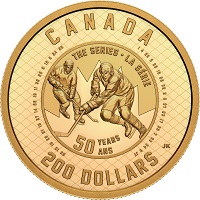
Face value: 200 dollars … Composition: 99.99% Pure Gold;
Mintage: 300; Finish: Proof; Weight: 31.16g;
Diameter: 30 mm; Edge: Serrated; Artist: Joel Kimmel (reverse).

2022 … $50 Pure Silver Coin –
The Magic of the Season
www.mint.ca
Celebrate the magic of the holidays with a surprise visit and an unexpected dash of colour! No matter our age, many of us would love to catch a glimpse of Santa Claus and his reindeer-powered sleigh, as they complete their round-the-world trip each Christmas Eve. Both Santa and one of his reindeer bring the magic to this fine silver coin, but the engraving also includes a hidden colour element that will really get you into the holiday spirit—simply view the design under a black light (included), and the effect will fill you with a childlike sense of awe and wonder.
Black light flashlight included … The engraving is captivating in natural light, but for the full viewing experience, view your coin’s reverse under a black light (included)—this will activate the technology and unlock the hidden features. Obverse pattern … We spread some holiday cheer on the obverse, too, where a Christmas tree pattern appears behind the effigy.
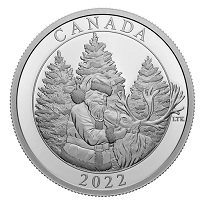
Face value: 50 dollars … Composition: 99.99% Pure Silver
with colour reveal technology; Mintage: 2,500;
Finish: Proof; Weight: 94.25 g; Diameter: 55 mm; Edge: Serrated;
Artist: Lisa Thomson-Khan (reverse); Susanna Blunt (obverse);
Packaging: Black clamshell with graphic beauty box.
DID YOU KNOW? … ***The 1823 poem A Visit from St. Nicholas (also known as ‘Twas The Night Before Christmas) first told us that Santa’s sleigh was pulled by “eight tiny reindeer.”
Your coin features a festive reverse design by artist Lisa Thomson-Khan, whose depiction of Santa Claus and one of his reindeer captures some of the magic of the holiday season. When the design is viewed under black light, colourful lights illuminate the snow-covered trees. The obverse features a tree background pattern and the effigy of Her Majesty Queen Elizabeth II by Susanna Blunt.
Samantha Strath, Engraver … “This was a fun one to engrave! Unlike designs based on vectors and geometrics, this one had lots of organic elements and flowing shapes, and a stylized art style that lends itself well to free-hand sculpting. The holidays are such a wonderful time, I loved working on a coin that captures some of the wonder and magic of the season.”
Melanie Luis, Product Manager … “This coin instantly brings back childhood memories of Christmas. I’m reminded of joyful traditions, past and present, but it’s the colour reveal that truly gives this coin that special touch of holiday magic.”

2022 … $20 Pure Silver Glow-in-the-Dark Coin –
Canada’s Unexplained Phenomena: The Yukon Encounter
www.mint.ca
The sightings continue: Our fifth UFO coin heads to Canada’s North for an encounter you won’t forget. Imagine driving on a snowy highway at night and seeing a row of lights in the sky… and you suddenly realize it’s a giant UFO! This is the scene depicted on our fifth Canada’s Unexplained Phenomena coin, which tells the story of a UFO encounter in the Yukon. On the night of December 11, 1996, at least 31 people in four different areas reported seeing a UFO in the sky. The bright lights described by the witnesses have been re-created on this rectangular coin’s reverse, where a more complete picture of the giant UFO comes into view when the black light paint technology is activated.
The 1996 Yukon UFO “mothership” incident is our fifth UFO story… December 11, 1996: It was a clear and cloudless night when a motorist driving along Fox Lake (Kwätän ’aya) on the Yukon’s Klondike Highway noticed a bright and unusual light. As he got closer, he observed a group of rectangular lights moving east in the sky. About a half-hour later, motorists in two separate cars also spotted a row of lights and got out of their car to get a better look. Within minutes, the UFO was almost directly above one of the witnesses, who described a large white beam coming from the centre of an object the size of a football stadium! Two more witnesses travelling from the other direction provided a similar description (with additional flashing lights), while a sixth witness saw multicoloured lights.
Earlier that evening, four people driving north towards Carmacks had observed a UFO with three flashing orange lights and several small white lights arranged in an elliptical pattern—a description similar to the one provided by a family of five who viewed the UFO from their house in Carmacks.
Near the village of Pelly Crossing, a trapper described seeing the same row of lights, as well as a luminescent green beam and two more rotating ones. Four women observed the UFO while taking a break from classes at the community college, and two more local witnesses compared the length of its lights to the width of the Big Dipper.
And finally, in the village of Mayo, the strange lights were observed by at least eight more witnesses, including out-of-town hotel guests and several teenagers who similarly described the mysterious object as being very large. What was it they saw? All we know is that a large UFO, one of the largest ever reported, was seen by multiple witnesses that night, and all within a short timespan.
Black light technology … Each coin comes with a black light flashlight, which activates the technology embedded in your coin’s reverse design. When viewed in normal lighting conditions, the coin shows the mysterious lights that appeared in the night sky; when the black light paint technology is activated, the full shape of the giant UFO is revealed! Horizontal orientation … Like 2020’s The Clarenville Event coin, this 1 oz. 99.99% pure silver rectangular coin features a horizontal orientation, which emphasizes the size of the Fox Lake UFO. Obverse field pattern … The obverse’s wormhole-like pattern is a nod to the UFO theme.

Face value: 20 dollars … Composition: 99.99% Pure Silver
with selective colour and black light technology; Mintage: 7,500;
Finish: Proof; Weight: 31.56 g; Dimensions: 49.80 mm x 28.60 mm;
Edge: Plain; Artist: Neil Hamelin (reverse); Susanna Blunt (obverse);
Packaging: Black clamshell with black beauty box.
DID YOU KNOW? … ***One of the motorists who spotted the UFO at Fox Lake attempted to relay what he had seen, but when he pulled out his two-way radio, he could only get static. Another witness noticed that her interior vehicle lights went dim and her music slowed when the lights appeared in the sky. ***Fox Lake’s name in the Dän K’e (Southern Tutchone) language is Kwätän ’aya, and it is located within the Ta’an Kwäch’än and Kwanlin Dün Traditional Territories. According to reports of the 1996 incident, the UFO would have travelled north from Fox Lake and into other territories. ***None of the 31 witnesses reported hearing any sounds emitted by the UFO.
The reverse design by Canadian artist Neil Hamelin features the artist’s rendition of a 1996 UFO encounter on the Yukon’s Klondike Highway, near Fox Lake (Kwätän ’aya). In this wintry scene, two motorists have pulled over to observe the mysterious lights in the night sky. The lights are amplified by black light paint technology; when activated, the effect provides a more complete picture of the huge UFO that was spotted in four different areas on the night of December 11, 1996. The obverse features a wormhole background and the effigy of Her Majesty Queen Elizabeth II by Susanna Blunt.

2022 … $5 Pure Silver Coin – Moments to Hold:
100th Anniversary of The Royal Agricultural Winter Fair
www.mint.ca
Share your moments from The Royal! Each year, hundreds of thousands of visitors, exhibitors and competitors come together at Toronto’s Exhibition Place for a celebration of excellence in agriculture, local food and equine sport. The Royal Agricultural Winter Fair has grown to become the largest combined indoor agricultural fair and equestrian competition in the world, and 2022 marks a major milestone for this annual event. The Royal’s centennial anniversary is commemorated on our final Moments to Hold coin; its reverse design highlights some of the events and exhibits featured at The Royal, where the champion rosette is the greatest aspiration of breeders, producers, growers and exhibitors alike.
The royal turns 100 … Are you a Loyal Royal? Celebrate the 100TH anniversary of The Royal Agricultural Winter Fair, the largest combined indoor agricultural fair and equestrian competition in the world! Held annually in Toronto, The Royal is Canada’s leader in showcasing agriculture, local food and equine excellence.
Special packaging … Each Moments to Hold coin comes in a colourful folder filled with information about the theme. The coin itself is enclosed in a removable capsule, which allows you to hold the “moment” in your hand and take a closer look at your collectible.
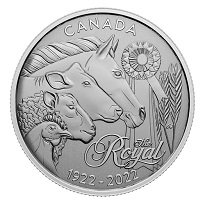
Face value: 5 dollars … Composition: 99.99% Pure Silver;
Mintage: 100,000; Finish: Specimen; Weight: 7.96 g;
Diameter: 27 mm; Edge: Serrated; Artist:
Claire Watson (reverse); Susanna Blunt (obverse);
Packaging: Custom folder with removable capsule.
DID YOU KNOW? … ***Part of The Royal Agricultural Winter Fair, The Royal Horse Show is a world-class equestrian event that draws more than 1,000 national and international riders. Over the course of the ten-day event, athletes and horses compete for over $1 million in prize money and the title of Royal Champion. ***If you love to cook, bake or preserve, you can enter your signature food item in one of several food competitions—categories range from jams and jellies to hot sauces, and butter tarts too!
Designed by Canadian artist Claire Watson, your coin’s reverse is double dated (“1922-2022”) to commemorate the 100TH anniversary of The Royal Agricultural Winter Fair. Its mix of crop and livestock-themed design elements represents some of the events and exhibits featured at The Royal, while the event’s logo (“THE ROYAL”) and a champion rosette honour a century of agricultural and equine excellence. The obverse features the effigy of Her Majesty Queen Elizabeth II by Susanna Blunt.

2022 … $30 Pure Silver Coin –
100th Anniversary of the Royal Agricultural Winter Fair
www.mint.ca
Celebrate the 100th Anniversary of the world’s largest indoor agricultural and equestrian event! Since its first opening day in 1922, the Royal Agricultural Winter Fair has been a place for Canadians to come together for world class competitions, interactive education and inspiring entertainment all in celebration of excellence in agriculture, local food and equine sport. The Royal has exciting experiences for everyone, as illustrated on this 2 oz. fine silver coin.
Experience the royal … Your coin’s reverse design highlights some of the exciting experiences to be had at The Royal, Canada’s premier showcase of agricultural products and horsemanship. A tribute to the past … On your coin’s reverse, the agriculture-themed tribute has been rendered in an Art Deco style—a nod to The Royal’s inaugural year, 1922.
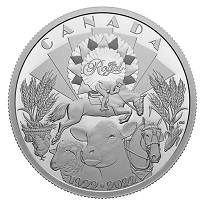
Face value: 30 dollars … Composition: 99.99% Pure Silver;
Mintage: 2,500; Finish: Proof; Weight: 62.69g;
Diameter: 50 mm; Edge: Serrated; Artist: Glen Green (reverse);
Packaging: Black clamshell with black beauty box.
DID YOU KNOW? … ***With a few exceptions, the Royal Agricultural Winter Fair takes place every November in Toronto. It is held on the grounds of Exhibition Place, where the iconic Coliseum was built for the inaugural fair—in fact, the fair’s grand opening was originally planned for 1921 but it was postponed to November 22, 1922 due to construction delays. ***The idea of a national agricultural exhibition took shape after the First World War, when a group of farmers came together and formed the Agricultural Winter Fair Association of Canada. In 1920, it received full support from all levels of government and King George V granted permission to include the word “Royal” in the event name. ***The Royal Horse Show is held annually as part of the Royal Agricultural Winter Fair. A world-class equestrian competition, it is the final leg of the North American Fall Circuit and typically features a star-studded field of top national and international riders.
On your coin’s reverse, the Art Deco-style design by artist Glen Green highlights some of the sights and events that have made the Royal Agricultural Winter Fair a premier showcase of agricultural and equestrian excellence. An array of livestock (chicken, sheep, cow and horse) and agricultural products surround a rider and horse, as they compete in the Royal Horse Show; behind them, The Royal logo appears on a champion rosette. The reverse includes the word “CANADA” at the top, while at the bottom, the dates “1922·2022” commemorate The Royal’s 100TH Anniversary. The obverse features the effigy of Her Majesty Queen Elizabeth II by Susanna Blunt.
Glen Green, Artist … “It has been an honour to create a coin that celebrates something this world-class event. Which has been a part of Canada’s history for 100 years. The challenge for this piece was to accurately incorporate the elements that represent different facets of the exhibition. Not only does The Royal reflect the diversity of Canada’s agricultural community, it’s also an inspiring representation of Canada’s quest for inclusiveness—it truly has something for everyone.”
Shelley Peterson, President and Chair of The Royal Agricultural Winter Fair … “We celebrate with pride The Royal’s tremendous 100 year history. The Royal’s legacy of recognizing and elevating the very best in Canadian agriculture, local food, and equine sport is long, and we are committed to the on-going evolution of sustainable farming and food production in Canada. This remarkable coin captures the very heart of The Royal– all the things that weave together to make The Royal a truly special event. Please join us this year in honouring our great past, while embracing the future.

2022 … Pure Silver Coin –
The Red Knight
www.mint.ca
Before the Snowbirds, there was the Red Knight! From 1958 until 1969, the Red Knight delighted spectators across Canada and the United States with awe-inspiring aerobatic displays. The Royal Canadian Air Force’s (RCAF) solo jet-aerobatic performer was equipped with the T-33 Silver Star (or “T-Bird”, CT-133) and later, the CT-114 Tutor, which were decked out in a bright colour scheme, iconic red. These aircraft, along with the distinctive knight’s helmet emblem they bore, have been colourfully recreated on this 99.99% pure silver tribute to the legendary (and much loved) Red Knight, whose show-stopping manoeuvres inspired a generation of air enthusiasts and enriched Canada’s aviation heritage.
Vintage colours … The Red Knight’s bright paint scheme and markings made it easy to spot, and its distinctive red colour has been recreated on this selectively coloured coin which has been crafted in 2 oz. of 99.99% fine silver.
Includes Red Knight emblem … The emblem of the Red Knight is also featured on this coin! The Red Knight’s helmet with golden plume was displayed on the aircraft’s nose from 1961 to 1969. The emblem is also subtly laser-engraved on your coin’s obverse, where this repeating element catches the light when the coin is tipped.
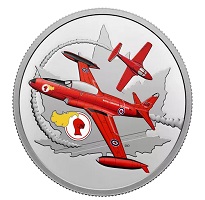
Face value: 30 dollars … Composition: 99.99% pure silver with selective colour; Mintage: 6,500; Finish: Proof; Weight: 62.69g; Diameter: 50 mm; Edge: serrated; Artist: David Oram (reverse), Susanna Blunt (obverse); Packaging: Black clamshell with black beauty box.
DID YOU KNOW? … *** Four T-33 aircraft were part of the Red Knight program from 1958 to 1968. One of them, RCAF serial 21574 (1961 to 1964), is on display at the Canada Aviation and Space Museum in Ottawa, Ontario, where you can get a close view of its day-glo red paint scheme and the Red Knight emblem on its nose—that emblem also appears on this coin! Another of the original Red Knights, serial 21630, is on display in Saskatoon and there are several other tributes to the Red Knight across Canada. The last remaining Tutor to have served as the Red Knight, RCAF serial 26153, is now on display in its original Golden Centennaires colours at the CFB Borden Museum. Following its Red Knight tour, this same Tutor served six years on the Snowbirds, including as Snowbird 1 in 1975-1976.
*** A few variations on the standard Red Knight colour scheme were introduced through the years – for example, the Tutor was painted vermillion red (instead of the original day-glo red) and had a white line that stretched from nose to tail. As for the Red Knight insignia, it started out as a black silhouette of a knight’s helmet in 1959; the more colourful version, the one reproduced on your coin’s reverse, was introduced in 1961 and served as the emblem for the remainder of the Red Knight program.
*** The CT-114 Tutor is the same aircraft type that is currently used by the Canadian Forces Snowbirds, 431 Air Demonstration Squadron. *** The Red Knight was among the 2020 inductees to Canada’s Aviation Hall of Fame (CAHF) as the recipient of the Belt of Orion Award for Excellence, a well-deserved honour.
Your coin’s reverse was designed by artist David Oram and pays tribute to the Red Knight, the Royal Canadian Air Force Training Command’s famous aerobatic performer from 1958 to 1969. Historical liaison was provided by authors J.C. Corrigan and D.V. Dempsey. To represent that timespan, the Canadair-built T-33 Silver Star is shown performing a manoeuvre alongside its eventual replacement, the Canadair-designed and built CT-114 Tutor (background). Accompanied by the red, gold and white Red Knight emblem, both aircraft are painted in their distinctive red colour schemes of the 1960s and set against the RCAF Roundel’s (pre-1965) maple leaf. The obverse features the repeating laser-engraved Red Knight emblem and the effigy of Queen Elizabeth II by Susanna Blunt.
About the Red Knight … A forerunner of the Canadian Forces Snowbirds, the Red Knight originated in Trenton, Ontario, and was active from 1958 to 1969. Although it was originally authorized to perform in just three air shows, the Royal Canadian Air Force Training Command’s solo aerobatic performer proved to be a hit with spectators and went on to make more than 600 air show appearances throughout its 12-year run. Its ability to perform manoeuvres within the confines of an airfield made it well suited for air shows in small communities and venues that could not accommodate larger display teams.
For the first three years, the Red Knight consisted of a single aircraft, a pilot and a support technician. Ultimately, a total of 17 pilots and two aircraft types—the T-33 from 1958 to mid-1968 and the Tutor in 1968 and 1969—took up the mantle of the Red Knight. The base of operations moved to RCAF Station Saskatoon in 1959, RCAF Station Portage la Prairie in 1961 and RCAF Station Moose Jaw in 1964 before returning to CFB Portage la Prairie in 1967. At the end of that air show season, the Red Knight was awarded the Centennial Medal for its “valuable service to the nation” after completing more than 100 performances, including flypasts and air shows alongside the Canadian Armed Forces Golden Centenaries during Expo 67. Budget cuts and a fatal accident resulted in the program’s untimely cancellation in early 1970. But the Red Knight will always hold a special place in Canadian aviation history as a prolific performer and one of the longest-running military aerobatic displays – in fact, its total number of performances is third only to today’s Snowbirds and CF-18 solo aerobatic displays which have been ongoing since 1971 and 1983 respectively.
David Oram, Artist … One of my fondest childhood memories was attending air shows and seeing the various aircraft that would perform in front of us and thousands of other spectators. Although I never saw a Red Knight perform, those early experiences provided inspiration for my coin design. I really wanted the airplane to stand out in its brilliant red paint scheme, while making sure the Red Knight insignia was clearly visible. It was fascinating to learn more about the aircraft and the history of the Red Knight while developing this design!
Matt Eggink, Product Manager … I had never heard about the Red Knight before! The moment I learned about the Red Knight, I was immediately intrigued and excited to learn more. Being a person who is naturally drawn to vintage subject matter, the Red Knight’s story and imagery captivated me. It was a true honour to bring this story onto a coin and I believe the team did a great job telling it!
John Charles Corrigan, Author of “The Red Knight” … All of the Red Knight pilots were flying instructors; the forty hours of practice required to reach maximum performance levels had to be flown after regular working hours or on weekends. Being selected as a Red Knight was a two-year commitment; the first year spent as the alternate pilot, flying the spare aircraft, acting as commentator, or standing-in for the Red Knight in times of illness or when scheduling conflicts occurred. These small Red Knight teams, consisting of from two to five men, received very limited support. This coin is a wonderful tribute to the pilots, and their crewmen, for those thrilling aerobatic displays performed wherever they travelled.
D.V. Dempsey, CD, Lieutenant-Colonel (Ret’d), Author of “A Tradition of Excellence, Canada’s Airshow Team Heritage” … The Red Knight solo display spanned the eras of two of Canada’s most famous aerobatic teams, the RCAF’s Golden Hawks (1959-1963) and the Canadian Armed Forces Golden Centenaries (1967). Throughout its 12-year tenure, the Red Knight was an inspiration to countless millions of spectators, its striking paint scheme a magnet to young and old alike. Many budding aviators like myself who marvelled at the Red Knight eventually joined the Snowbirds or performed as CF-18 demo pilots to carry on the legacy of Canada’s rich air show heritage. It was thus most fitting to see the Red Knight inducted into Canada’s Aviation Hall of Fame and now to be honoured by this beautiful commemorative coin.


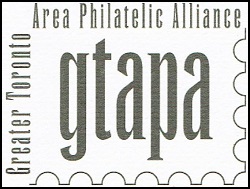
www.gtapa.org
The GTAPA is committed to promote and stimulate
the art of philately to all ages for fun,
culture, education, and friendship.




